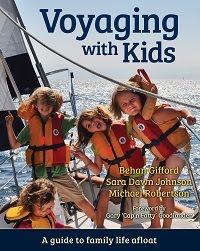 |
| Windy and Eleanor enjoying the pool at the fall we hiked to. It was about an hour from the anchorage with no permits required, no trash cans about, no warning signs, no signs of anyone but us. |
“Mom, Mom! Come here, quick!”
Windy sprinted on deck. Eleanor was stripping down to her bathing suit, trying to find her mask, and pointing at the giant manta ray swimming in circles and doing summersaults right next to Del Viento.
“Can I go in, can I go in, please!”
When the second ray showed up, Windy joined Eleanor and when a third joined the party, it was enough for Frances to ignore the jellyfish stings she’d gotten on her last two swims and she jumped in too. For twenty minutes, the three chased after the three.
We were told to expect relatively low visibility in the waters around the Marquesan islands, and I suppose it is in a relative sense, but we can still see 50 feet in the cobalt-colored water of this deep Fatu Hiva anchorage.
When we arrived, there were 18 other boats here and we were forced to fall back and drop in 138-feet. Despite winds blowing 20 knots on two nights, despite our having only 300-feet of rode out (all chain) for a scope of only a bit better than 2:1, we haven’t dragged. Since then, many boats have left and a few more have arrived. Two current boats are kid boats—one family from Monaco and one from Belgium, six kids between them—and another kid boat, Australians, are due today. As I write this, Windy and the girls are on a hike with the six other kids, aged 7 to early teen.
 |
| Frances looking down at the anchorage. |
Rays aren’t the only interesting marine life we’ve encountered. There are eels along the shore that flit about in the rocky nooks. We all watched one quickly slither up from the water about two feet (roughly his body length) to grab a crab on the rocks and quickly carry it back underwater for a feast. There are also these fish that seem to walk on the rocks right at the water’s edge. Crawdads are everywhere, including in the fresh water streams on the island. The largest I’ve seen was about 3-inches long.
Local boats have dropped by several times to trade. The first time, two men wanted to trade for alcohol. We showed them a bottle of wine we were willing to trade for a dozen fresh eggs. “Oui, oui!” they said, racing ashore with our plastic egg carton. Thirty minutes later they returned, our egg carton empty, explaining that all the eggs had chicks in them. They did bring a handful of oranges hoping we’d be enticed enough to let go the wine, but we declined. They left the oranges anyway, despite what we hope were polite protestations. The next boat was also two men, one of whom we recognized as the Pushy Man, but he didn’t recognize us. These chaps also wanted alcohol, but offered only three pamplemousse. We offered kids’ toys and even some rope for their pamplemousse, but they passed. Finally, this morning a family with two small kids stopped by with more pamplemousse. We showed the same kids’ stuff—a bracelet making kit and a stuffed animal and puzzle and a shirt—and they were eager to trade.
 |
| Capturing the scale and majesty of scenes like this, with the camera, is impossible for me. Trust me, these pics just aren't doing it. |
It’s easy to imagine spending 3 months here, settling into the low-key vibe, getting to know individuals by name, and trading away everything we own to stay fed. But we wouldn’t have to trade exclusively. We’re also finding food on the ground, among rotting fruit strewn about, freshly fallen from trees in more remote areas. Yesterday we hiked up to a waterfall and returned with our backpacks full of guava, limes, lemons, a coconut, and Thai basil. We’re reticent to pick fruit from any tree, but feel okay stockpiling the freshly fallen among their rotting comrades.
The fruit we all love the most are the common bananas. In D.C. and Mexico, we’d all eat one or so when they came home with us from the grocery store, but most of them wound up in banana bread or the freezer for smoothie fodder. Here, the bananas taste so exquisite, with such a perfect texture—even days after they appear past their prime, that Eleanor—definitely the pickiest banana eater among us—ate 7 yesterday alone. Unfortunately, we haven’t found any banana stalks on the ground. The massive stalk we traded for on our second day was exhausted this morning, so please spread the word that we’re willing to trade.
 |
| Frances and Eleanor watching a manta summersault in front of them. |
 |
| Oh, the drama. |
 |
| This is my favorite home in Hanavave. |
 |
| Hanavave from up high, the anchorage would be visible to the left, around that mountain. |
 |
| Bull. |














Loving your stories and awesome photos! Are you going to visit any other islands in the Marquesas?
ReplyDeleteAwesome stuff
ReplyDeleteLoving the posts! Thanks, from s/v shawnigan @ www.afamilyafloat.com
ReplyDeleteI don't know if my comment was accepted since I wasn't signed in to my account. I wanted to share how much we're enjoying reading of you South Pacific adventures! Been home a week after bashing ahead of Blanca up the Pacific side of Baja and have been catching up on your blog. A truly priceless family experience. Love to all from the crew of Citla.
ReplyDelete